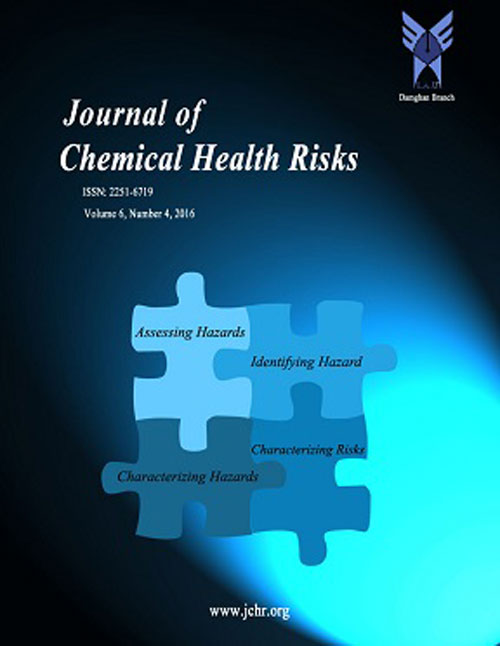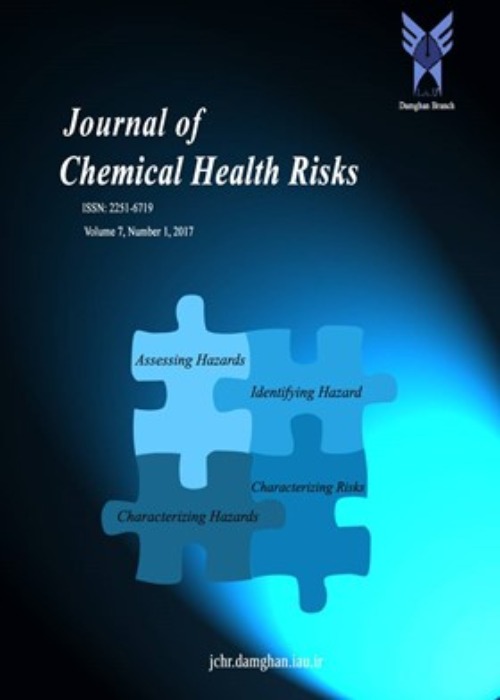فهرست مطالب

Journal of Chemical Health Risks
Volume:8 Issue: 2, Spring 2018
- تاریخ انتشار: 1397/04/20
- تعداد عناوین: 7
-
-
Pages 95-105The concentrations of some heavy metals were determined in some pasta consumed in Nigeria, with a view to providing information on their dietary intake and exposure of consumers. The metals were determined by atomic spectrometry after acid digestion. The results (µg/g) were in the following ranges: locally manufactured pasta: Ni (0.005 - 0.738); Mn (0.2 - 1.938); Cd (Nd to 0.015); Cu (nd - 0.456); Zn (0.071 2.902); Pb (0.278 - 0.692); Cr (nd - 0.206) while imported pasta concentrations were: Ni (0.039 1.301); Mn (Nd - 1.515); Cd (Nd 1.059); Cu (nd - 0.333); Zn (nd - 2.024); Pb (0.313 1.085); Cr (Nd - 0.233). The estimated daily intakes of these pastas were below the tolerable daily intake limits of the metals stipulated by FAO/WHO and JECFA. The hazard quotient and total hazard index (THI) values were less than 1 indicating no adverse health effect. However, THI in imported macaroni was appreciable.Keywords: Dietary intake, Heavy metals, Nigeria, Locally manufactured, Imported, Pasta, Hazard quotient, Target hazard index
-
Pages 107-115An issue rose for industrial safety and successful address of crisis involves quick and pragmatic decision that would reduce losses and accidents. This will become practical when in addition to studying of past accidents the industrial executives create the necessary readiness to face risks through precise estimation of the consequences of eventual accidents. The present research concerns modeling the consequences of chlorine gas dispersion in the wastewater installations. The transfer of knowledge and information in this study were gained from modeling the dispersion of chlorine in the water treatment plants, useful for managers and executives. Detection and specifying the risks of chlorine for the public and especially the staff and those residing near the water treatment plant, would result in the appropriate action against this lethal substance, which is the subject of this study. Identification of risks related to foreign agents and their negative impacts on water treatment plants containing chlorine tanks is among the objectives of this study. The modeling and accurate specification of the scope and level of danger created following the dispersion of chlorine was done using the PHAST software, which allowed a clear identification of danger zones created by the dispersion of Chlorine. This text reports the radius of areas affected by chlorine dispersion as well as the results of different conditions after running the model for variable physical and process conditions, and given their availability, these results can be compared with each other.Keywords: Modeling, Accidents, Risk, Chlorine dispersion, Water Treatment Plant, PHAST software
-
Pages 117-126A robust linear quantitative structure-property relationship (QSPR) model has been constructed to model and predict the refractivity indices of 101 organic compounds as common halo-derivatives of normal paraffin by application of the structural descriptors combined with multiple linear regressions (MLR) method. In the main part of this study, theoretical molecular descriptors were adopted from the original pool through the stepwise feature selection method. A simple model with low standard errors and promising correlation coefficients was obtained. MLR method could model the relationship between refractivity and structural descriptors, perfectly. The accuracy of the proposed MLR model was illustrated using cross-validation, validation through an external test set, and Y-randomization techniques. The linear techniques such as MLR combined with a successful variable selection procedure are capable of generating an efficient QSPR model for predicting the refractivity indices of different compounds. The constructed model, with high statistical significance (R2train = 0.926; Ftrain = 240.675; R2test = 0.947; Ftest = 52.978; REP (%) = 1.219; Q2LOO = 0.914 and Q2LGO = 0.914), could be adequately used for the prediction and description of the affecting parameters on refractivity behavior of similar or even unknown compounds.Keywords: QSPR, Refractivity index, MLR, Molecular descriptors
-
Pages 127-133Curcumin is the effective constituents of Curcuma longa, which inhibit the growth of cancer cells. Prevention of breast cancer, as one of the common cancer type with serious health problem, is an area of interest in breast cancer research. In this study, we have evaluated the effects of curcumin on the cell proliferation of human breast cancer cell line (MCF-7) compared to non-cancer line (MCF-10A). The cell lines were subjected to increasing doses of curcumin ranging from 0 to 30 μg/ml. Cell viability was quantified by MTT assay. In vitro clonogenic survival assay was performed on MCF-7 cells. Curcumin inhibited the growth of malignant cells in a time and dose-dependent manner. Calculated IC50 value for MCF-7 cells in 48 h was 12 μg/ml. Overall, 45%70% decrease in colony formation was observed in MCF-7 cells treated by 30-60 μg/ml curcumin respectively. The result of our study confirms the potential cytotoxic effects of curcumin in breast cancer cell line. It could be considered as a potential chemopreventive agent in breast cancer treatment.Keywords: Anticancer, Curcumin, Cytotoxicity, Breast Cancer
-
Pages 135-145A novel and efficient hollow fiber-based method, viz. magnetic solvent bar liquid-phase microextraction (MSB-LPME) combined with gas chromatography-flame ionization detection (GC-FID) was successfully developed for the trace determination of selected polycyclic aromatic hydrocarbons (PAHs) in environmental water samples. The target analytes were extracted from sample solution to the organic solvent immobilized in a fiber. After extraction, the analyte-adsorbed magnetic solvent bar could be readily isolated from the sample solution by a magnet which could greatly simplify the operation and also decline the total pretreatment time. The bar was first eluted with methanol, evaporated to dryness while the residue was dissolved in toluene and finally injected into GC-FID. Begin with, effective parameters controlling the performance of the microextraction were evaluated and optimized. The values of the detection limit of the method were in the range of 0.05-0.08 µg L-1 and the RSD% values for the analysis of 10.0 µg L-1 of the analytes was below than 5.8% (n= 6). A good linearity (0.998 ≥ r2 ≥ 0.994) and a broad linear range (0.1-200 µg L-1) were obtained. The method was eventually utilized for the preconcentration and determination of the PAHs in environmental water samples and satisfactory results were obtained.Keywords: Environmental water samples, Gas chromatography-flame ionization detection, Magnetic solvent bar liquid-phase microextraction, Polycyclic aromatic hydrocarbons
-
Pages 147-156Investigating of pigments changing trend in different stages of fruit maturity is essential for utilizing from nutritional value of pigments in fresh fruit consumption, unfortunately not known for Iranian fresh figs until now. In order to achieve this goal, this experiment was conducted in a factorial experiment based on a complete randomized design with three replications in Estahban Fig Research Station, Estahban, Iran in 2017. The first factor was fig cultivar in four levels (Sabz, Siah, Matti, and Shahanjir), and the second factor was fruit harvesting stage at three levels (before maturity, maturity and after maturity), and the third factor was the storage temperature at two levels (4 and 22 degrees Celsius). The levels of chlorophyll a and b, total chlorophyll, carotenoids and anthocyanin in fresh fruits of fig cultivars at different harvesting stages and storage temperatures were measured. The results showed an increasing trend in some pigments such as chlorophyll b, total chlorophyll, and carotenoids during the development of fig fruit maturation. The highest amount of tested pigments in this experiment was in Siah cultivar, which indicates the higher nutritional value of these fruits for fresh consumption. The majority of pigments content increase in harvested fruit after maturity. Therefore, in order to use the nutritional value of pigments in fresh figs, figs be harvested and used for fresh consumption after maturity.Keywords: Fig cultivars, Harvesting stages, Pigments
-
Pages 157-175Brassica juncea arawali plants were exposed to 0, 100, 200, 400 and 800 mg/l concentrations of Lead (Pb) and Nickel (Ni). Plants were treated with control, ethylene diamine tetraacetic acid (EDTA) and salicylic acid (SA) chelant applications at Micromodel experimental site of Indian Institute of Technology, Delhi in 2009. A high level of combined metal concentrations (1600 mg/l) was taken to assess the feasibility of phytoextraction on a high-level metal contaminated soil. Plants were analyzed for growth parameters, biochemical parameters and metal accumulation. EDTA decreased all morphological parameters whereas SA stimulated them. All biochemical parameters showed declination with increasing Pb and Ni concentrations. A higher accumulation of chlorophyll, soluble sugars, soluble proteins and proline occurred in Indian mustard plants treated with SA. Pb and Ni accumulation in plants increased in a dose-response manner with increasing levels of metal treatments and time. EDTA was found to be more efficient chelant than SA for removal of Pb and Ni from contaminated soil.Keywords: Brassica juncea, Ethelyne diamine tetraacetic acid, Lead, Nickel, Phytoextraction, Salicylic acid


